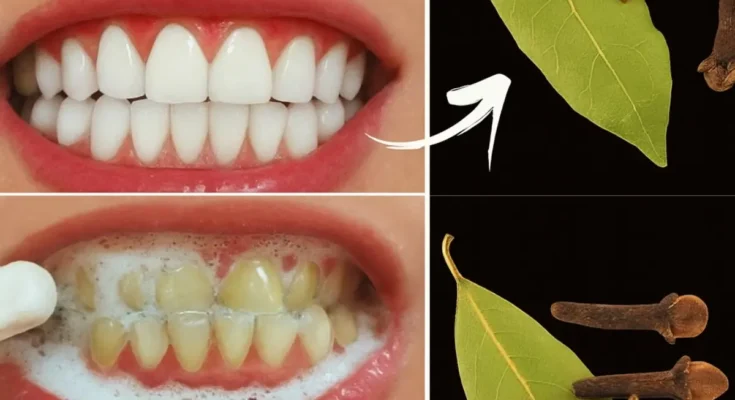Did you know that Americans spend more than $1.4 billion each year
on teeth whitening products, according to the American Dental
Association? From whitening strips to expensive in-office treatments,
the quest for a brighter smile is a booming industry. But while these
methods can be effective, they often come with side effects such as
tooth sensitivity, gum irritation, or high costs that make them less
accessible for everyone.
This is where traditional remedies step in. For generations, people in
different cultures have turned to natural ingredients like bay leaves
and cloves not only for cooking but also for oral care. Both are rich in
compounds that may help reduce stains, freshen breath, and support
healthier gums. Could this simple kitchen trick really be a natural
alternative to commercial whitening products? In this article, we’ll
uncover the science, cultural traditions, and practical DIY methods of
using bay leaves and cloves for whiter teeth—alongside safe practices
and realistic expectations.
Why Bay Leaves and Cloves Are Linked to Dental Care
Bay Leaves: The Fragrant Protector
Bay leaves contain essential oils, tannins, and flavonoids that act as
natural cleansers. Traditionally, powdered bay leaves have been used in
some cultures to scrub away surface stains from teeth. Their mildly
abrasive texture, when dried and ground, may help polish enamel
gently.
Cloves: The Natural Oral Healer
Cloves are famous for their compound eugenol, a natural antiseptic
and mild anesthetic widely used in dentistry for toothaches and gum
health. Clove powder not only freshens breath but also supports oral
hygiene by reducing harmful bacteria in the mouth.
When combined, bay leaves and cloves create a natural remedy
believed to brighten teeth, reduce odor, and support healthier gums.
Ingredient Key Compound Potential Benefit
Bay Leaves Tannins, Flavonoids Surface stain removal, mild polishing
Cloves Eugenol, Antioxidants Oral bacteria reduction, fresh breath
DIY Method: Bay Leaf and Clove Powder for Whiter Teeth
Here’s a simple way to try this traditional trick at home:
Ingredients:
2 dried bay leaves
3-4 whole cloves
Instructions:
Toast bay leaves lightly until crisp, then grind into fine powder.
Grind cloves into powder and mix with bay leaf powder.
Dip a damp toothbrush into the mixture and gently brush your teeth
for 1-2 minutes.
Rinse thoroughly with warm water.
Frequency: Use 1-2 times per week. Avoid overuse to protect enamel.
Tip: You can also mix the powder with a drop of coconut oil for added
antibacterial benefits and smoother application.
What Science and Tradition Say
While there is limited clinical research on bay leaves and cloves
specifically as whitening agents, both ingredients have strong
traditional and scientific backing in oral care.
Cloves in Dentistry: Eugenol is still used by dentists in fillings and as a
natural analgesic for tooth pain.
Bay Leaves in Folk Remedies: In Mediterranean and Middle Eastern
cultures, bay leaf poultices and powders have long been used for oral
hygiene.
Antioxidant Effects: Both bay leaves and cloves contain antioxidants
that protect oral tissues from oxidative stress.
Real-Life Example
A family in rural India has passed down the practice of brushing with
clove and bay leaf powder for generations. While not a substitute for
modern toothpaste, they report fresher breath and visibly cleaner
teeth after regular use.
Pros and Cons of Using Bay Leaves and Cloves

Pros Cons
Natural, chemical-free option Results are gradual, not instant
Affordable and easily available Overuse may irritate gums or enamel
Supports overall oral health Limited scientific evidence on
whitening effect
May reduce bad breath and
bacteria Cannot replace professional cleaning
Other Natural Whitening Alternatives
If bay leaves and cloves don’t suit you, there are other natural options
worth exploring:
Baking Soda: Gentle abrasive that helps lift surface stains.
Activated Charcoal: Absorbs plaque and particles, though can be
messy.
0il Pulling with Coconut Oil: Traditional Ayurvedic practice to cleanse
the mouth and support gum health.
Strawberries: Contain malic acid that may brighten enamel when used
sparingly.
Practical Safety Tips

Do not use bay leaf and clove powder daily—stick to once or twice
weekly.
Always rinse thoroughly to avoid residue.
Continue brushing with fluoride toothpaste twice daily for cavity
protection.
Consult your dentist before starting any DIY whitening method,
especially if you have sensitive teeth or gum issues.
Conclusion
Bay leaves and cloves may not deliver the same dramatic results as
professional whitening treatments, but they offer a natural, affordable,
and time-tested way to support oral health and gradually brighten
teeth. When used safely and consistently, this simple kitchen trick can
complement your dental care routine while connecting you to
centuries of traditional wisdom.
FAQs
Does this method really whiten teeth?
It may help reduce surface stains and brighten enamel gradually, but
results vary from person to person.
Is it safe for sensitive teeth?
Use with caution. If you experience irritation, discontinue and consult a
dentist.
How long before I see results?
Visible results may take several weeks of consistent use.
Can I replace toothpaste with this method?
No. This should only supplement regular brushing and dental care.
Disclaimer: This article is for informational purposes only and does
not replace professional dental advice. Always consult a qualified
dentist before trying new oral care methods.



